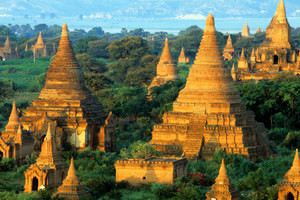Travel Answers (Formerly Travel2)
For travelers who wish to get to know south Korea well, this itinerary includes both the popular highlights and a couple of lesser-visited places that come as both a pleasant surprise and the opportunity to see a more local side of South Korea.
The journey starts in Seoul where you will spend a full day visiting popular monuments and attractions such as Gyeongbokgung Palace, Insadong antique street and Namsangol Hanok Village. Asia Answers recommends adding a day in Seoul if you wish to visit the demilitarized zone (DMZ).
Next you’re off to Gimpu domestic airport for your flight to Jeju Island, situated off the southern coast, a mesmerizing destination renowned for its natural beauty and unique culture. Jeju boasts stunning landscapes including lush forests, dramatic cliffs, pristine beaches, and volcanic craters. The island offers travelers diverse flora and fauna, a mild climate, rich heritage reflected in its traditional stone houses, vibrant festivals, and the famous Haenyeo (granny divers) culture.
Following Jeju, take a short flight to Busan, south Korea’s second largest city and a vibrant metropolis brimming with energy and charm. Nestled between mountains and sea, Busan boasts pristine beaches such as Haeundae and Gwangalli. Its bustling markets offer a tantalizing array of fresh seafood and local delicacies.
From Busan, it’s just an hour by road to Gyeongju, often dubbed the "museum without walls," a former capital city steeped in rich history and cultural heritage. Its landscape is adorned with countless archaeological sites, royal tombs, Buddhist temples, and UNESCO World Heritage Sites such as Bulguksa Temple and Seokguram Grotto.
After Gyeongju, you’ll head by road to Jeonju stopping enroute at Juknokwon Bamboo forest and Damang where a road lined with large sequoia trees creates an amazing visual. In Jeonju, visit a traditional Hanok village.
Next, drive to Buyeo, once the capital of the ancient Baekje Kingdom, where you will see archaeological sites and historic relics. Continuing on you’ll reach Daejeon, a modern and dynamic city which is home to prestigious universities and research institutions; Korea’s Silicon Valley. Its dynamic cityscape, green spaces, and culinary diversity offer a glimpse of the Korea of the future.
From the modernity of Daejeon, you’ll spend time exploring a Korean Folk Village in Yongin, before moving on to Suwon Hwaseong fortress, an impressive structure built in the 18th century.
Finally, arrive back in Seoul for a last night before leaving Korea.
Vacation Inclusions
- Round trip transfers
- Transportation throughout
- Domestic flight Seoul to Jeju
- 9 nights 4-star accommodation
- Full day private Seoul Highlights tour
- Two full day private Jeju Island tours
- Full day Busan Highlights tour
- Full day Gyeongju Temples and Palaces tour
- Half day Damyang Highlights tour
- Jeonju Hanok Village visit
- Full day private Buyeo and Daejeon Highlights tour
- Korean Folk Village visit
- Gyeonggi-do Fortress visit
- 8 breakfasts, 7 lunches
- Entrance Fees
Featured Destinations
Daejeon
Daejeon
Daejeon, South Korea, located 95 mi/150 km south of Seoul, hosted the 1993 World Expo, which has been converted to a theme park focused on science and technology. West of town is Gyeryong Mountain, where there are hiking trails, beautiful fall foliage, and the Gapsa and Donghaksa temples nestled in the hills. Southeast of town is Jikjisa Temple and its 1,000 statues of the Buddha as a baby (the entire temple complex, in a gorgeous setting in the mountains, is wondrous). The Yuseong Hot Springs are also worth a visit. About 50 mi/80 km northeast of Daejeon is Songnisan National Park. A wonderful place to experience Korea's Buddhist culture firsthand, it houses Beopjusa Temple, home to Korea's tallest Buddha statue (109 ft/33 m high). The Korean government named its mountain peaks one of the country's eight most scenic attractions. Also not far from Daejeon is the Twin Lions Stone Lantern, the Stone Lotus water container and other national treasures, all set in a beautiful, wooded mountain setting. The park is especially beautiful during spring and fall. Allow two days for Daejeon and the surrounding area—we recommend overnighting near one of the temples rather than in the city itself.
|
Destination Guide
|
Jeonju
Jeonju
The epicurean capital of Korea and a paper-producing center 125 mi/200 km south of Seoul, Jeonju draws travelers to its sixth-century Geumsan (Gold Mountain) Temple and 40-ft-/12-m-high Buddha. The city also maintains a Hanok village with about 800 traditional houses. About an hour's drive east, Maisan Provincial Park provides a beautiful setting for the many pagodas of the temple Tapsa (especially in the spring and fall). Other attractions in the area include Deokyosan National Park and the Mireuksa stone pagoda. We suggest one day in Jeonju.
|
Destination Guide
|
Jeju Island
Jeju Island
Large Jeju Island 60 mi/100 km off the coast of the mainland and 300 mi/485 km south of Seoul has a distinctive history, dress, architecture, language and tradition. Jeju is an extremely popular tourist destination for Koreans, especially honeymooners. Millions of won have been pumped into building deluxe hotels and modernizing infrastructure. Although development has somewhat ended the island's isolation, it hasn't eroded its charms—it is still a great place to visit. Jeju seems a world away from the mainland, even though it's relatively easy to reach—only an hour's flight south of Seoul or a several-hour ferry ride from Busan, Mokpo or Wando. If you have a choice of when to go, visit in late spring, when Jeju is covered with beautiful yellow yuchaehwa flowers. The island's primary attractions are beaches, fishing, casinos, scuba diving, a weavers' village (Hallim), hot springs and three stunning coastal waterfalls, particularly the Jeongbang Falls at Seogwipo, which plunge almost directly into the sea. In friendly and festive Jeju, the largest city on the island, there's a Folkcraft and Natural History Museum and an interesting market. About 4 mi/6 km from the city is Moksuk-won, a natural sculpture garden of stone and wood. On the south side of the island, Jeju Folk Village Museum, a collection of traditional houses with musical performances and displays, is well worth a visit. Also on the island is the tallest mountain in South Korea, Hallasan, which is topped with snow in the winter. There are hiking trails on this extinct volcano, and it has an impressive crater lake. Be sure also to visit some caves: According to legend, three gods emerged 2,500 years ago from the Samseonghyeol (literally "three clans' holes") to create the Jeju Island people. On a drive around the island, note the black-lava statues of old men, called harubang: Their origin is unknown and the subject of much debate among anthropologists. You can also watch as divers (traditionally women) hunt for clams, pearls and abalone. A dying breed, these incredible women dive into the ocean's depths for long periods of time without using any scuba or snorkeling gear. Other attractions include saltwater baths (in Sinyang, Hyeopje and Jungmun), the Bijarim nutmeg forest, tangerine groves, the Sanbanggul Buddhist Grotto, the Jungmun beach-resort area and Manjang Cave (the world's longest lava tube). Plan at least two to three days to explore the island.
|
Destination Guide
|
Seoul
Seoul
Seoul, capital of South Korea, lies in the northwest of the country on the Han River 37 miles from the coast. Landmarks in Seoul include the National Museum, featuring collections of Korean art and artefacts; the National Science Museum; Ch'anggyong, Ch'angdok, Kyongbok, and Toksu palaces; Chong-myo Shrine; a Roman Catholic cathedral; and zoological and botanical gardens. Other sights include the bell tower, which contains a large bronze bell inscribed with the date 1468, and the remains of the ancient stone wall that once encircled the city.
|
Destination Guide
|
Pusan (Busan)
Pusan (Busan)
Korea's "museum without walls" is akin only to China in its depth and cultural wonder. From Pusan, you can journey to the ancient Silla capital of Kyongju, a dynasty which reigned in Korea for almost a thousand years. Today this small provincial town is virtually a museum without walls, dotted with many splendid ruins. Nearby, the forested mountains and valleys shelter hundreds of beautiful Buddhist shrines including the renowned Sokkuram Grotto, and Tongdosa and Pulguksa Temples. Pusan is also a shopper's mecca and Korea's vital southern link to Japanese and American trade.
|
Destination Guide
|
Gyeongju
Gyeongju
If your schedule permits stopping at only one city other than Seoul, that city should be Gyeongju, 165 mi/265 km southeast of Seoul. It was the capital of the Silla Kingdom (57 BC-AD 935) and has a high concentration of temples, statuary and burial mounds, as well as an excellent historical museum. One of the highlights of your visit will be a walk through Tumuli Park, where you'll stroll among the burial mounds of 20 kings, some several stories high and looking more like hills covered with soft green grass than the royal tombs that they are. (Oddly enough, the park was only dedicated in the 1970s. Before that, the area was residential.) Just a few have been excavated, and the interior of only one is open to the public. Inside, an exhibit re-creates what it looked like when the mound was first explored, and some of the original contents are on display. Most of the finds, however, are exhibited in the Gyeongju National Museum, along with other artifacts from Gyeongju's golden age. Outside of town is Bulguk Temple, one of the most beautiful temples in the country. It's a large complex with wonderful architecture, pagodas and statuary. There are other temples and mounds near Gyeongju (some have larger-than-life stone soldiers and bureaucrats to guard and guide the departed kings in the afterlife) as well as the Seogbinggo (where ice was kept long before refrigeration), Anapji Pond (a part of the royal pleasure garden), a very early star-gazing tower and other relics. Also within easy driving distance are the Seokguram Grotto (containing an exquisite stone Buddha image surrounded by friezes) and the Poseokjeong Pavilion. In the mountains surrounding the city are thousands of Buddhist temples, inscriptions and pagodas (the roads to some are impassable without a four-wheel-drive vehicle). You could spend weeks driving around, but two or three days will give most travelers a taste of the area. One other nearby attraction merits mention, though it is difficult to get to: the underwater tomb of King Munmu (AD 661-681). The tomb is submerged in shallow water in the middle of a little island about 300 ft/90 m offshore. Legends say that King Munmu asked to be buried there so he could return as a dragon to protect his people from invasion. Visitors must bargain with a local boat owner to get to the tomb. If time permits, visit the village of Yangdong, just south of Pohang. Ignored by most tourists, the village seems immune to all forms of modernization.
|
Destination Guide
|
View Full Itinerary
Valid Date Ranges






